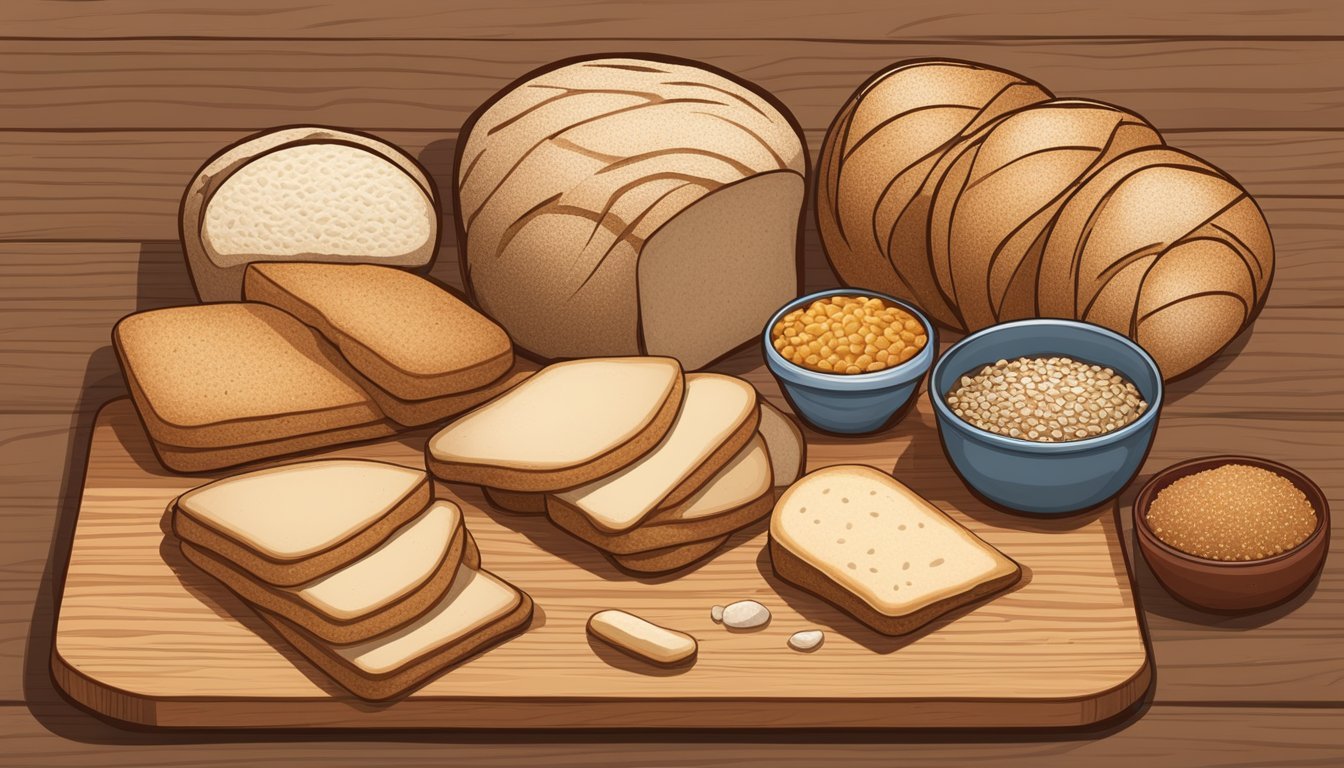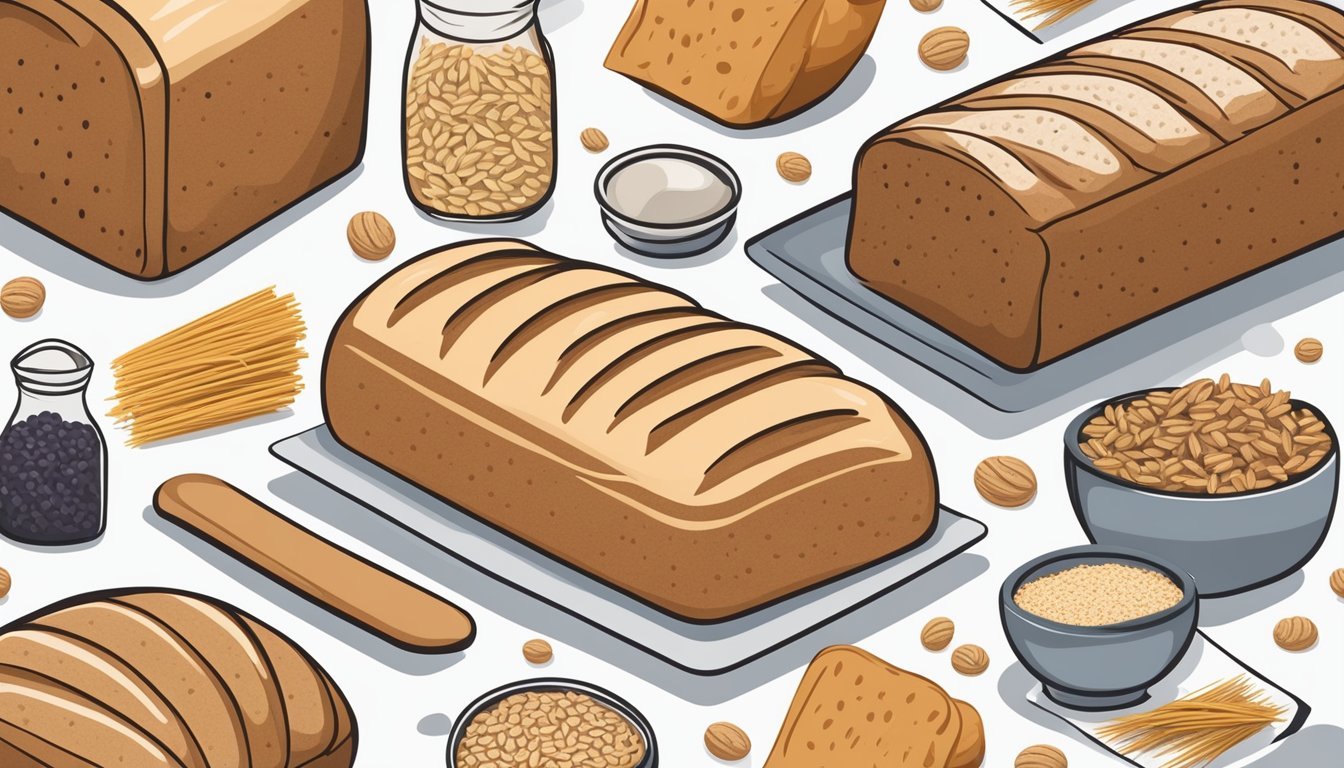Whole Wheat Bread Substitutes
Healthy Alternatives for Your Diet
In recent years, a growing awareness of dietary preferences and health considerations has led many individuals to seek alternatives to whole wheat bread. Whether motivated by gluten sensitivity, a desire to follow a low-carb diet, or the goal to lose weight, consumers are exploring a variety of bread substitutes. These alternatives not only cater to health requirements but also offer diverse flavors and textures. Among the popular choices are sourdough made from fermented grains, which can be easier to digest and may offer enhanced nutrient availability.
For those following a low-carb or ketogenic diet, substituting whole wheat bread with options such as cloud bread—a light, protein-rich bread alternative—enables them to enjoy a similar experience without the carbohydrates. Others may turn to rye bread, which is high in fiber and potentially beneficial for weight management. Choosing the right bread substitute can significantly impact one's diet, whether one aims to reduce carb intake, manage gluten intolerance, or simply incorporate more variety into their meals.
While many bread substitutes are gluten-free and fit well into specialized diets, it's crucial to consider their nutritional profiles. For instance, some alternatives may have higher levels of certain macronutrients like protein or fiber, while others might contain added sugars or fats. Making informed choices based on nutritional content and personal health goals is key to finding a suitable whole wheat bread replacement.
Nutritional Profile of Whole Wheat Bread
Whole wheat bread is valued for its nutritional richness, offering a comprehensive balance of macro and micronutrients. It is a significant source of dietary fiber, protein, and essential vitamins and minerals, contributing to its status as a staple in many health-conscious diets.
Macro and Micronutrients
Whole wheat bread is made from flour that contains all parts of the grain: the bran, germ, and endosperm. This inclusion ensures that it retains a higher content of nutrients compared to its refined counterparts.
Fiber: Essential for digestive health, whole wheat bread is typically high in fiber, particularly when the whole wheat is less processed.
Protein: It provides a modest amount of protein, which is essential for body repair and muscle building.
Carbohydrates: Whole wheat bread is predominantly composed of carbohydrates, providing a steady energy source.
Healthy Fats: The germ portion of the wheat includes healthy fats, which are necessary for overall health.
Tables illustrating the average nutritional content of whole wheat bread often highlight:
Nutrient Amount per serving (approx.) Calories 100-120 Carbohydrates 20g Protein 4g Fat 1.5g Fiber 3g Iron <10% RDI B Vitamins Varies (often enriched)
Health Impacts of Whole Wheat
Whole wheat bread, as part of a balanced diet, contributes to several health benefits due to its micronutrient content.
B Vitamins: Often enriched in whole wheat bread, they play a crucial role in energy metabolism and the proper functioning of the nervous system.
Iron: A mineral important for blood production, whole wheat bread can contain varying levels of iron.
Minerals: Besides iron, whole wheat bread may contain minerals like potassium, essential for maintaining healthy blood pressure levels.
Regular intake of whole wheat can lead to:
Improved blood sugar regulation due to the slower digestion of complex carbohydrates and fiber.
Potentially lower cholesterol levels, thanks to the fiber's ability to bind cholesterol in the digestive system.
For those with gluten sensitivity or celiac disease, whole wheat bread is not suitable due to its gluten content. Gluten-free alternatives are recommended for individuals with these conditions. Despite whole wheat's healthful properties, it's important to consume it as part of a varied diet for optimal health benefits.
Reasons for Choosing Bread Substitutes
When considering alternatives to whole wheat bread, individuals often seek options for health-related reasons, such as gluten intolerance and weight management, or to align with specific dietary preferences.
Managing Celiac Disease and Gluten Sensitivity
For individuals with celiac disease or non-celiac gluten sensitivity, avoiding gluten—a protein found in wheat, barley, and rye—is crucial to managing their condition. Gluten can trigger harmful reactions, leading to symptoms ranging from gastrointestinal distress to neurological issues. Consequently, they must choose bread substitutes that are certified as gluten-free, like bread made from rice or tapioca flour.
Low-Carb and Weight Loss Goals
Those aiming to lose weight or follow a low-carb diet often find traditional wheat bread incompatible with their dietary goals. Wheat bread, being high in carbohydrates, can be replaced with options that are low in carbs yet high in fiber, helping to promote satiety. Alternatives such as flaxseed or coconut flour bread provide a healthier, lower-carb option for those wanting to maintain a calorie deficit without compromising on texture or taste.
Alternative Dietary Choices
Dietary choices, including veganism or the desire for more vegetable-inclusive meals, may prompt the search for healthier bread substitutes. These choices often involve plant-based and grain-free breads made from nuts, seeds, and legumes, which are not only healthy in terms of nutrient content but also suitable for those seeking to diversify their diet or reduce their intake of processed grains.
Types of Whole Wheat Bread Substitutes
When exploring whole wheat bread substitutes, one can find options ranging from vegetable-based bread alternatives to grain-free and low-carb breads. These substitutes cater to a variety of dietary preferences and needs, including gluten-free diets and those seeking nutrient-dense foods.
Vegetable-Based Options
Vegetable-based bread alternatives offer nutrient-dense substitutes, rich in vitamins and fiber. One popular option is lettuce wraps, which utilize large lettuce leaves as a bread substitute, ideal for sandwiches and burgers. Another innovative substitute is cauliflower pizza crust, made by processing cauliflower into a dough-like consistency, which is then baked. Other vegetables like sliced sweet potatoes and bell peppers can serve as a base for toppings traditionally found on bread.
Grain-Free Alternatives
Grain-free alternatives are especially suitable for those following a gluten-free diet. Flours made from almond, coconut, and chickpea provide healthy alternatives to bread and are often used in baking goods like muffins and cookies. These flours are lower in carbohydrates and higher in protein and fiber compared to traditional whole wheat flour. Almond flour and coconut flour can be used to make various baked goods, while chickpea flour is an excellent base for savory dishes.
Low-Carb Breads
Low-carb breads are an attractive option for individuals managing blood sugar levels or those pursuing a low-carbohydrate diet. Cloud bread, also known as oopsie bread, is a light and airy bread alternative made mainly from eggs and cream cheese, offering a gluten-free and low-carb option. Another choice is bread made from flaxseed meal, which is high in omega-3 fatty acids and fiber, promoting a healthy alternative to traditional bread. These breads tend to be softer and more delicate, often used for sandwiches and can be toasted for a crispier texture.
Recipes and Preparation
When seeking alternatives to traditional whole wheat bread, one can explore a multitude of recipes and preparation methods. Whether one opts for homemade substitutes that cater to specific dietary needs, or chooses commercially available options, there are various avenues to discover bread alternatives that are both tasty and nutritious.
Homemade Substitutes
For those venturing into homemade bread substitutes, Sourdough bread stands out as a tasteful option. With its unique taste and texture derived from fermented grains, sourdough offers enhanced nutrient availability. A basic sourdough recipe could start with a blend of flour and water, allowing a natural fermentation process that can take several days for the starter to develop before baking.
For gluten-free and low-carb diets, alternatives like almond flour bread tick the right boxes. A simple recipe might combine almond flour with eggs, oil, and rising agents to achieve a bread-like consistency. Other nutritious flours include millet and spelt, which can be used to make bread with a denser texture.
Ezekiel bread and sprouted bread are made from a wide variety of sprouted grains and beans, including wheat, millet, barley, and lentils. They are not gluten-free but offer a high-fiber, protein-rich alternative. A recipe may involve soaking and sprouting these grains and beans before grinding, mixing, and finally baking.
Gluten-free bread options can also encompass a range of materials from nut & seed flours to beans or vegetables. Baking a gluten-free loaf often requires a blend of these flours to mimic the texture of wheat bread. A well-balanced recipe ensures that the final product is moist and flavorful without the gluten.
Commercially Available Alternatives
Those looking for commercially available alternatives will find a plethora of options designed to satisfy their taste and dietary preferences. Gluten-free breads are increasingly common and often use rice or tapioca starch as a base. Supermarket shelves display various low-carb and gluten-free options, including rye bread which is denser and richer in fiber, and often preferred for its bold flavor profile.
In the realm of commercial products, the texture and taste can greatly vary between brands. It is recommended to read ingredient labels to ensure the product meets nutritional needs and does not contain unwanted additives.
When it comes to preparation, commercial gluten-free and alternative breads can sometimes benefit from being toasted to improve their texture and flavor. Always follow the storage and handling instructions on packaging to maintain freshness and quality.
How to Incorporate Substitutes in Your Diet
When seeking to replace whole wheat bread in a diet, the key is finding alternatives that not only cater to health considerations but also provide versatility and flavor. Here are practical ways to introduce bread substitutes into different meals throughout the day.
Breakfast Ideas
For a nutritious start to the day, one might consider sweet potato toast as a hearty alternative to traditional toast. To make it, slice sweet potatoes lengthwise and toast until tender. Sweet potato toast can be topped with avocado, nut butter, or even a poached egg for a well-rounded meal. The sweetness of the potato pairs well with these toppings, creating a balanced and flavorful breakfast.
Lunch and Dinner Applications
Lunch and dinner provide ample opportunity to utilize bread substitutes in more creative ways. For instance, collard greens can be used as wraps for sandwiches. The leaves are large and sturdy enough to hold fillings such as slices of meat, cheese, and hummus. Another option is to use grilled portobello mushrooms as buns for burgers. The mushrooms offer a meaty texture and a rich flavor that complements various proteins. Lastly, thin slices of eggplant can be grilled and used as layers in a lasagna, providing a substantial base without the need for bread.
Snacks and Quick Bites
When it comes to snacks or quick bites, options like cucumber slices and cheese can replace crackers. These alternatives not only reduce carbohydrate intake but also add a refreshing crunch and are simple to pair with a range of toppings. Another quick snack could be hummus spread over bell pepper slices or cherry tomatoes filled with tuna or chicken salad, offering both convenience and taste.
Health Considerations and Tips
When exploring whole wheat bread substitutes, consumers should consider their nutritional needs and health objectives. Each alternative comes with its own profile of nutrients and potential additives, which necessitates a careful approach to selection and consumption.
Reading Labels and Ingredients
Consumers should prioritize reading labels meticulously to identify the presence of refined wheat, added sugars, and additives such as excess salt. Gluten-free options are necessary for those with celiac disease or gluten sensitivity, but it's important to check if they might be compensating with other additives. Whole grains and sprouted grains are often desirable for their higher nutrient content, with an emphasis on products that display "100% whole grain" on their packaging.
Look for:
Whole or sprouted grains as main ingredients
Minimal added sugars and salt
Recognizable and limited ingredient lists
Be cautious of:
Long lists of additives
Misleading terms like "multigrain" which may not equate to whole grain
Balancing Your Diet
Incorporating substitutes for wheat bread should align with an individual's broader dietary needs. Substitutes like sourdough or rye bread can offer more fiber and sometimes protein while potentially being easier to digest due to fermentation. Integrating a variety of grains can also provide a wider spectrum of nutrients. For those following a low-carb diet, leveraging vegetable-based alternatives can ensure nutritional diversity without the high carbohydrate content.
Components for a balanced diet may include:
A mix of protein, fiber, and healthy fats
Sufficient caloric intake based on personal health goals
Avoiding Common Pitfalls
One common pitfall in selecting bread substitutes is choosing options overloaded with fat or those labeled as gluten-free but have similar or higher calorie counts than their wheat counterparts due to added sugars and fats. Another is assuming that light or white bread is a healthier choice simply because it's lighter in texture or color; these can sometimes be made from heavily refined wheat and provide less nutritional value.
Best practices include:
Avoiding substitutes that counteract dietary goals (e.g., low-carb but high-fat)
Choosing substitutes that maintain a balance of taste and health benefits






